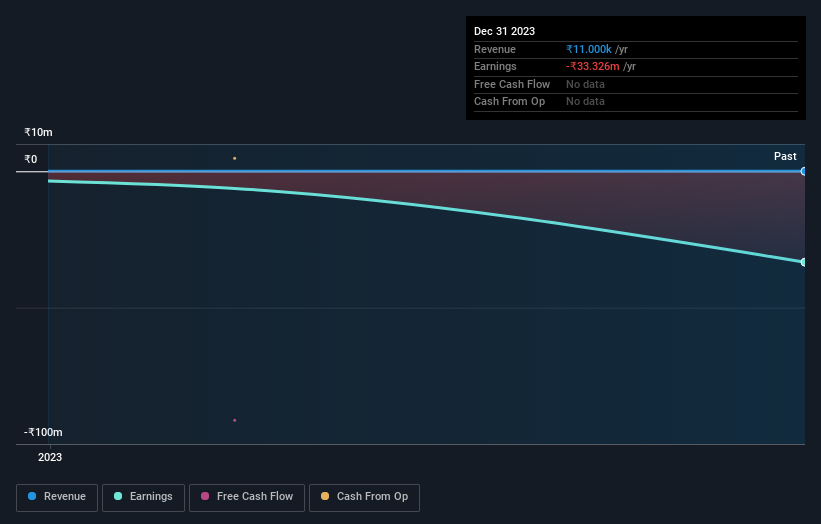- India
- /
- Real Estate
- /
- NSEI:BLAL
BEML Land Assets Limited's (NSE:BLAL) market cap dropped ₹1.1b last week; State or government bore the brunt

Key Insights
- BEML Land Assets' significant state or government ownership suggests that the key decisions are influenced by shareholders from the larger public
- India owns 54% of the company
- 14% of BEML Land Assets is held by Institutions
If you want to know who really controls BEML Land Assets Limited (NSE:BLAL), then you'll have to look at the makeup of its share registry. We can see that state or government own the lion's share in the company with 54% ownership. That is, the group stands to benefit the most if the stock rises (or lose the most if there is a downturn).
And following last week's 10% decline in share price, state or government suffered the most losses.
Let's take a closer look to see what the different types of shareholders can tell us about BEML Land Assets.
View our latest analysis for BEML Land Assets

What Does The Institutional Ownership Tell Us About BEML Land Assets?
Many institutions measure their performance against an index that approximates the local market. So they usually pay more attention to companies that are included in major indices.
We can see that BEML Land Assets does have institutional investors; and they hold a good portion of the company's stock. This can indicate that the company has a certain degree of credibility in the investment community. However, it is best to be wary of relying on the supposed validation that comes with institutional investors. They too, get it wrong sometimes. It is not uncommon to see a big share price drop if two large institutional investors try to sell out of a stock at the same time. So it is worth checking the past earnings trajectory of BEML Land Assets, (below). Of course, keep in mind that there are other factors to consider, too.

Hedge funds don't have many shares in BEML Land Assets. The company's largest shareholder is India, with ownership of 54%. With such a huge stake in the ownership, we infer that they have significant control of the future of the company. For context, the second largest shareholder holds about 7.0% of the shares outstanding, followed by an ownership of 2.3% by the third-largest shareholder.
While it makes sense to study institutional ownership data for a company, it also makes sense to study analyst sentiments to know which way the wind is blowing. Our information suggests that there isn't any analyst coverage of the stock, so it is probably little known.
Insider Ownership Of BEML Land Assets
The definition of company insiders can be subjective and does vary between jurisdictions. Our data reflects individual insiders, capturing board members at the very least. Company management run the business, but the CEO will answer to the board, even if he or she is a member of it.
Insider ownership is positive when it signals leadership are thinking like the true owners of the company. However, high insider ownership can also give immense power to a small group within the company. This can be negative in some circumstances.
Our data cannot confirm that board members are holding shares personally. It is unusual not to have at least some personal holdings by board members, so our data might be flawed. A good next step would be to check how much the CEO is paid.
General Public Ownership
With a 31% ownership, the general public, mostly comprising of individual investors, have some degree of sway over BEML Land Assets. This size of ownership, while considerable, may not be enough to change company policy if the decision is not in sync with other large shareholders.
Next Steps:
I find it very interesting to look at who exactly owns a company. But to truly gain insight, we need to consider other information, too. Be aware that BEML Land Assets is showing 3 warning signs in our investment analysis , and 2 of those can't be ignored...
Of course this may not be the best stock to buy. Therefore, you may wish to see our free collection of interesting prospects boasting favorable financials.
NB: Figures in this article are calculated using data from the last twelve months, which refer to the 12-month period ending on the last date of the month the financial statement is dated. This may not be consistent with full year annual report figures.
Valuation is complex, but we're here to simplify it.
Discover if BEML Land Assets might be undervalued or overvalued with our detailed analysis, featuring fair value estimates, potential risks, dividends, insider trades, and its financial condition.
Access Free AnalysisHave feedback on this article? Concerned about the content? Get in touch with us directly. Alternatively, email editorial-team (at) simplywallst.com.
This article by Simply Wall St is general in nature. We provide commentary based on historical data and analyst forecasts only using an unbiased methodology and our articles are not intended to be financial advice. It does not constitute a recommendation to buy or sell any stock, and does not take account of your objectives, or your financial situation. We aim to bring you long-term focused analysis driven by fundamental data. Note that our analysis may not factor in the latest price-sensitive company announcements or qualitative material. Simply Wall St has no position in any stocks mentioned.
About NSEI:BLAL
Mediocre balance sheet very low.
Market Insights
Community Narratives



